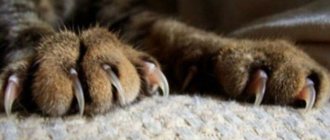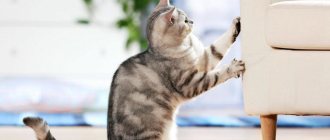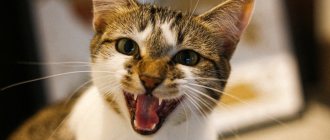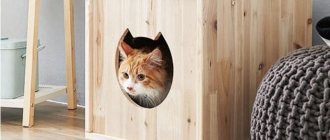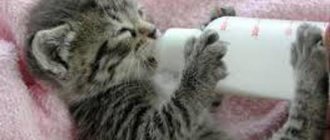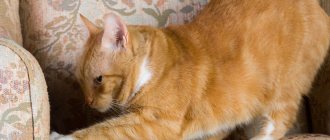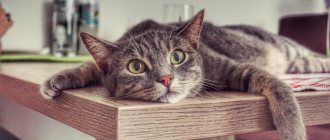Cats, like any living beings, have their own temperament, character, and disposition. Despite the fact that furry pets give us a lot of joy and positivity, some of the pranks of tailed pranksters cause a lot of trouble and inconvenience.
For example, pets can tear up furniture, carpets, tear off wallpaper from walls, chew indoor flowers, and shoes. Undoubtedly, bad habits need to be eradicated at an early age, since it is more difficult for adult animals to instill correct behavioral manners. To raise a well-mannered, obedient cat, you need time, patience, and the right approach. And in this article we will tell you how to stop a cat from jumping on walls and tearing wallpaper.
Why is the cat looking at the wall?
Almost every owner of a pet cat notices how their pet stares for a long time and carefully at the wall, as if he has found something very important and interesting for his eyes.
Many people wonder why the cat is looking at the wall. Moreover, the wall to which the pet’s attentive gaze is directed is often ordinary, there is nothing special in it for a person, without bulges and depressions, without spots and dots. Often a wall can become a place of attraction for inquisitive cat eyes for a very long time. Are there clear answers to this question? Undoubtedly. First of all, cats and cats are predators. Their main purpose in the house is to catch mice. And although our apartments do not have these rodent pests, feline animals never lose their natural instincts. For this reason, nothing can hide from their watchful eyes, neither day nor night.
Why are they doing that
Domestic cats are deprived of the pleasures that hunting brings them. The only way to diversify your leisure time is to try to steal something. Pet theft and acrobatic stunts can be justified by the desire to get what the owners do not give. You have to take risks, this process brings real pleasure to cats.
The aroma of victory calms cats: sleeping on the table or stealing food when the owners are not looking is very risky and entertaining. All cats love to climb high surfaces, so they choose an advantageous position for hunting. In the wild they use trees. The higher the cat is, the stronger its influence.
Feeling grateful, pets try to please their owners. If you find a gift from a furry prankster near your bed, rejoice at such care - he is not indifferent to you.
Facts and figures
A cat or cat that sits, seemingly relaxed, perfectly sees everything that is happening nearby and around. Then, everyone knows the fact that representatives of the cat world are well oriented in the dark, they see perfectly in the absence of at least some glimmer of light. By nature, cats are nocturnal predators. They need special vision at any time of the day for hunting, and the latter for survival. That's why nature bothered to give them everything they needed for this :
- Cats' vision is 6 times sharper than humans.
- Just as in the Russian song they sing “I recognize my dear one by his gait,” so a cat sees its owner 100 meters away.
- Thanks to the special convexity of the eyes, each meow is able to monitor what is happening around him within a radius of 190-270 degrees, which is 1.5-2 times the all-round visibility of a person.
- In the dark, the pupils of a cat's eyes dilate significantly, and the illumination of the retina increases tenfold.
- A cat and a cat can distinguish up to 50 flickers per second, which is 2 times the frame rate.
- Cats and cats have the same retinal photoreceptors - rods and cones - as in humans. But the ratio of the former is 25:1, while the latter is 4:1.
- Behind the retina of cats' eyes is the tapetum, a greenish-yellow reflective layer of cells that enhance vision.
- Plus, for successful hunting of cats in pitch darkness, not only their keen eyes are responsible, but also a very developed sense of smell, as well as all kinds of whiskers-navigators that detect the smallest vibrations in the air.
Square and circle
When a cat looks closely at a wall that has not been subject to any changes by members of the household, this means that the wall has been “occupied” by a midge, or a mosquito, or a spider; a speck of dust, speck, fluff, etc. has settled on it. As a hunter, it is important for a cat to know “where the wind is blowing”, i.e. what it is. Plus, the meowing creature, as one of the most curious animals in the world, is interested in the development of this situation. Surely, the cat is wondering where this insect came from, and where it will go later. This wall is like Kazimir Malevich’s “Black Square” - a bright circle for a cat to think about.
And another answer: for the tailed purr, as one of the cleanest animals on Earth, it is important to know when the wall will shake off this disgrace, or when its owner will do so. The gaze of the pet speaks eloquently about this, even screams. A cat and a cat speak a similar language to people.
When a cat looks into the eyes of its owner, it means that the animal wants something: to understand the mood of its older brother, to catch the wave of his mood. And then, having figured out this moment for himself, he begins to say with his eyes what he needs - either a fun game, or a hearty meal, or change the water in the bowl, or the filler in the tray.
How to avoid mistakes in parenting
If you want to change your cat's behavior, be prepared to change with it. Don't leave piles of dirty dishes in the sink or on the counter. Don't accumulate waste in the trash can. Make sure that your pet always has fresh food in his bowl; do not provoke the animal to look for it on your dining table.
If your tailed pet throws cat tantrums before eating: meows loudly, standing on its hind legs, and impatiently scratches the kitchen furniture or even you with its front claws, do not encourage such ugly behavior by giving the animal food at this moment.
Train your pet's patience and keep your cat calm while you give her food. Place a bowl of food only when the animal behaves adequately and calmly for at least a couple of moments. Gradually, this time needs to be increased little by little, and with due diligence, you will ensure that before eating your cat behaves like a real gentleman or a real lady.
Retraining a pet is not an easy task. But the time and effort spent will certainly be worth it. Under no circumstances should you hit an animal or punish it with any other physical force. This way you will only lose the cat’s trust. Try to break away from the monitor or TV screen and spend time with your pet, who, perhaps, is so thirsty for your attention and is forced to while away the time in the kitchen, where there are so many goodies and interesting things.
Source
Wall or void
The process when a cat looks at a wall or in a corner is reminiscent of meditation. A cat's brain is the size of a walnut. And a cat thinks no less than ours, and also draws conclusions. But the instincts of the pet take over everything; he will look at the wall, since any point on it serves as a hypothetically moving object. And if she also moves her paws, then she is potential prey.
Also, a cat and a cat can stare into space for a long time. What is emptiness for humans is not always the case for cats. A tiny ray of light can play its game in space, or some small object casts a shadow, and it trembles. Or a light breath of wind blows crumbs across the floor, creating the effect of a living creature.
There is an opinion that cats are able to see brownies, ghosts, otherworldly entities, incorporeal creatures from a parallel world. The cat is an ancient animal that came to us from the distant past and preserved religious things from there. Anything is possible. No one can confirm this hypothesis, nor can anyone refute it, why a cat is the first to be let into a new house.
Caprice or illness
A cat can not only look at the wall, but also rest its head against it, while still growling and releasing its claws. The Internet is teeming with photos and videos of a tailed pet resting its head against a wall or corner. Looks funny. But in most cases, such behavior of a cat’s pet is a fairly serious signal of its ill health.
For example, in the absence of the owner, the cat jumps and runs around the house. Cat Kevin McCallister “home alone” can fall off a shelf and land on his paws, fail to fit into a kitchen corner on sharp turns and hit a corner, or get a huge slap on the head from an overturned hard object. Finally, the same wall can cause illness. The cat ran and hit his head against the wall with all his might.
A cat can complain of being unwell using “meow-meow”, but it won’t help, people don’t understand. When the animal runs into a wall, it complains of pain in the head. The wall is a cat's assistant - it tells the owner what is hurting his beloved cat.
A person often notices something similar behind himself. When he has a headache, he wants to push it against the wall. A hard wall seems to be able to drown out the pain in my head. In the case of a cat, the wall seems to scream that the family pet needs medical attention.
We recommend reading: Why Cat's Eyes Are Variably Watery
There was a situation when a cat fell out of a high-rise building window. He survived, they picked him up, carried him into the apartment and released him, he crawled to the wall and rested his head against it. At a veterinarian's appointment, the cat's owners learned that their pet had a concussion.
In addition to a concussion, the reasons for a cat running into a wall can be various poisonings, metabolic disorders, nervous shock, and worst of all, tumors of the brain or spinal cord . You definitely need to contact an experienced veterinarian and, when all the bad things are behind you, your pet will again enjoy life, watch its “cartoons” on the wall and gratefully purr fairy tales in the ear of its beloved owner.
A cat can not only look at the wall, but also rest its head against it, while still growling and releasing its claws. The Internet is teeming with photos and videos of a tailed pet resting its head against a wall or corner. Looks funny. But in most cases, such behavior of a cat’s pet is a fairly serious signal of its ill health.
Effective methods for weaning yourself from a bad habit
It is imperative to wean your cat from walking on the kitchen table and other surfaces in this room, and for several reasons. The first of these is hygiene. Nobody likes cat hair as a seasoning. In addition, the cat steps on the floor with its paws, climbs under sofas and on cabinets, where it is very dusty. And in general, many microorganisms that are relatively safe for cats can be harmful to people. No matter how clean she may be, her concepts of cleanliness are still different.
Secondly, household and cutlery may be unsafe for the animal itself. Thirdly, a cat, while living in a house, must still follow basic rules of behavior. Even if an animal considers itself the rightful owner of the apartment and the king of the world, it still must adhere to some rules of the hostel.
From infancy, the owner must explain in a popular manner, understandable to the cat, but without using physical measures, how to behave in the house.
If time is lost, and the cat has acquired the habit of sitting, walking or sleeping on the table, then experts offer several tips for weaning the animal from incorrect behavior.
Most of these animals categorically do not like such influences. In order for it to understand what they want from it, the procedure needs to be repeated several times. That is, if a cat jumps off in response to a “shot” and leaves, then you need to detain it, put it back on the table and spray it with a pistol. Then she will understand that the owner disapproves of her behavior, and thus punishes her.
Another method to play on cats’ dislike of water is to place a baking tray filled with liquid on the table. The item should be secured well, for example, with double-sided tape, and water should be poured. Then you need to remove from the cat’s access area all objects that it can use as intermediate steps on the way to its goal. That is, move the chairs in, remove the shelves if possible. The cat will have to jump from the floor. Having raised a sheaf of spray, the cat will experience a number of unpleasant sensations, and is unlikely to risk repeating the maneuver. However, it is still worth repeating the experiment, in case the knowledge gained is not fixed in the cat’s memory at once.
Treating kitchen surfaces with strong-smelling substances is another effective way to wean your cat from walking on them. These animals have an extremely negative attitude towards strong odors, especially those emitted by acids. Spraying essential oils with citrus scents and treating surfaces with a solution of acetic acid will help rid your cat of a bad habit.
Another common method to stop a cat from jumping anywhere is to cover the surface with foil. The rustling of this material is extremely unpleasant and even scary for these animals, and the pet will quickly stop jumping into such a dangerous place, in its opinion.
Another option is tape. This is one of the most commonly suggested methods. By placing pieces of this sticky material on the table, you can permanently discourage the animal from jumping into an unauthorized place. An almost win-win option is foil and tape at the same time.
Why does the cat run around the apartment like crazy?
This article provides information to give you an idea of what you're dealing with in typical pet situations. In any case, you need to contact a veterinarian, since it is impossible to make a diagnosis in absentia.
The cat is running around the apartment and yelling, hiding why and what to do
There may be several reasons for this strange behavior - a desire to go to the toilet, you gave cat food to eat, perhaps the pet wants to go for a walk. Try to observe the animal to draw certain conclusions.
If the whole point is a walk, then let him out during these hours; the food can be changed to regular food. Well, doing something with the toilet is not easy, because predicting when you want to visit the toilet is not always easy.
Why does the cat run to the old apartment if we have moved?
Cats, just like people, have their own attachments and needs, and it is not at all surprising that they strive to go where they grew up. Ask the new owners not to give them anything to eat. In your new home, protect your pet with your affection and care, so adaptation will be much easier for him.
Why does the cat run around the apartment like a mad animal and get scared?
This behavior can mainly be observed in those cats that do not walk outside much. Such a manifestation is a kind of natural instinct. The animal, in a way, models the situation that could have happened if it had been in the wild. The frequency of this behavior depends, first of all, on the cat’s temperament.
Why does a cat run around the apartment at night?
The hunting instinct influences the fact that at night cats are more sensitive: they pay attention to all sounds, creaks, and smells. This is especially true for young individuals. Since behavior is determined by nature itself, doing something will not be easy.
The cat runs after its tail and growls at it for reasons
This cat behavior is not a cause for concern. The animal plays and trains. Thus, the hunting instinct is developed.
Why does a cat run and meow before going to the toilet?
This crazy behavior is understandable - physical activity is aimed at stimulating intestinal function, thus speeding up the bowel movement process. Not all pets go to the toilet calmly.
The cat runs away from the rat, what is the reason
Many owners may notice that the cat does not catch rats as expected, but runs away from them, but why does this happen? In this case, genes can take their toll. Not all pets are hunters by nature, and some simply never do it. Therefore, when a cat sees a rat, it takes it for danger and tries to hide.
Why does a cat run away from a person?
The reason why a cat can run away from a person is because he once scared her. In this case, the animal will avoid repeated contact in every possible way.
If a kitten runs around with its mouth open, is this normal and what to do?
If a kitten not only runs around with its mouth open, but also constantly breathes like that, then this may indicate the presence of some health problems. When running, he may breathe this way because he is tired or because he is thirsty. In the second case, it is enough to give water and time to rest; as for health problems, only a doctor can help here.
Why does a cat run in circles or sideways?
As practice shows, this condition occurs after a stroke. In order to avoid complications, it is recommended to take the animal to a veterinarian.
The cat is running like crazy, twitching its back, how to calm it down
Common fleas can provoke this condition. To eliminate them, it is enough to buy a special collar or drops. If you cannot cope with the problem on your own, visit a veterinarian.
Why does a cat run at your feet when a small child cries?
Many cats react very sensitively to children, they feel sorry when they cry, play with them when they are having fun. If you notice that the cat behaves this way, then you can conclude that he is also trying to distract and calm the baby.
Cats, just like people, have their own attachments and needs, and it is not at all surprising that they strive to go where they grew up. Ask the new owners not to give them anything to eat. In your new home, protect your pet with your affection and care, so adaptation will be much easier for him.
Effective methods for weaning yourself from a bad habit
Proper education
Since cats have high intelligence, use the same methods in the education process as with a mischievous young child. Strictly tell your pet the reason for your dissatisfaction; cats easily understand intonation and pick up on changes in the owner’s mood.
To formulate in your pet’s perception that such actions are prohibited, do not make mistakes in raising him from an early age: you should not sit the kitten at the table or even pick him up during meals. Do not treat your cat to any food from the table, avoid creating unnecessary associations in the animal. Make it clear to your pet that your table is a forbidden area for him.
Sharp sounds
Sharp sounds and clapping of hands is a fairly simple but effective method that does not require any additional financial or energy costs. An undoubted advantage is that it will definitely not harm the pet in any way.
If you see that the cat is about to jump on the table, clap your hands sharply and loudly. The animal will not be able to ignore this, it will become wary and change its mind about doing what is forbidden. After 3-4 times of this simple method of re-education, the animal will develop a reflex, and with relief you will notice that the four-legged urge to climb on the table has disappeared.
Water
This method is more labor-intensive, but no less effective. At the same time, it is absolutely safe and you have no reason to worry that your pet may get injured. Use double-sided tape to secure heating pads filled with water to the table surface. Jumping on them, the animal feels a strange gurgling noise under its paws, the nature of which it cannot understand; in addition, the cat loses stability and strives to retreat from the table as quickly as possible. Practice shows that after several unsuccessful attempts to walk on the table with heating pads, the pet gives up the idea of climbing on the table, considering this place to be scary and unsafe.
Metal objects
It should be noted that this is not the safest way to wean your pet from forbidden actions. But if none of the above has the desired effect, you can try it. However, carefully ensure that the animal is not injured; you should not experiment with the method when the pet is left at home alone.
Nothing will quickly discourage the desire to climb on furniture than the crash from the fall of empty iron cans placed on the table. While jumping or while walking, your pet will certainly hit a couple of cans, the loud sound of which will definitely not please the mustachioed mischief-maker. An even greater effect can be achieved if you pre-fill tin cans with coins.
Can a cat yell for no reason?
In nature, stray cats do not use meowing to communicate with each other. Meowing is a cat's way of communicating with its owner. Cats of some breeds, for example, Siamese-Oriental Croup, Cornish Rex, Turkish Angora, have a habit of talking to their owners: when asked “How are you?” may respond with a loud “Meow.”
We recommend reading: Why Kitten Vomits Yellow Liquid
But these sounds cannot be compared with the loud screams that cats of these breeds, as well as those of the eastern group (Burmese, Bombay, Bengal, Ocicat, Egyptian Mau) emit during sexual heat. But this is only one, although the most common cause of screaming, and there are many of them, many of which are age-related.
Why does a cat constantly meow?
Let's figure out why cats meow, keeping us awake.
A small kitten aged from birth to 3 weeks cries if:
What to do?
In order for the baby to calm down, it is necessary to warm it up to a normal temperature of 38°C, either by calling the mother cat, who abandoned the child for a long time, or by placing a bottle of warm water as a heating pad. After he warms up, you can feed him.
Older kittens scream for their mother in case of danger, any problem (got lost in a large apartment, felt lonely) or in pain due to accidental injuries.
In a new home, the kitten also calls the cat with a loud cry, in this case the only thing that can be done is to caress, warm, play - to let the cat child understand that he is not alone, he is loved and cared for.
If you do not plan for the kitten to have access to your bed, you need to teach him to spend the night alone from the first day, and therefore, in the first days, when the kitten is not yet accustomed to the new routine, you may have to endure some sleepless nights.
Effective ways
The following methods can help you stop your cat from climbing on tables.
You can also place empty tin cans on the edge, which will rattle when you jump. Any flat wide board, stacks of notebooks or magazines that will fall to the floor along with the cat will do.
This method does not work on all tailed animals - some of them are not stopped by smells on the way to their cherished goal. Whether this is true or not in your case, you can find out only by trying this method.
The main thing is not to use this method when raising kittens, who are not yet so dexterous and may get injured if they fall.
Just be careful with this method on a furry cat: the tape may stick to his fur too much, and you won't be able to get rid of the tape fragments until you cut them off along with the fur.
Whichever option you choose from the above, you must always make sure that the table is empty, that is, there is no food or objects on it that can be used as toys.
Screams of young cats and cats
Young, sexually mature, uncastrated cats begin their calls closer to spring - in February or March, calling for a partner. If you do not plan to get offspring from your animal, the easiest way to stop nocturnal yelling is to castrate your pet.
By doing this, you will only improve the quality of his life, eliminating possible negative consequences (pyometra in cats, territorial markings of cats), and lengthen his life.
Other causes of loud screaming may include:
- The desire to attract attention - this is how cats can beg for a treat, demand to open a closed door, demand to play.
- Anxious state - cats sense the approach of a natural disaster or weather change within a few days, and can scream to wake up their owners if there is a fire in the house or with neighbors.
- The struggle for dominance in a pride - if there are several cats in the house and more than one stud cat, a young cat can find out with an older one “who is boss” even without a fight, just loud screams.
- reacts to the behavior of their owners ; unfortunately, owners treat their pets adequately. If a cat is beaten or shouted at, then in response the cat may begin to show aggression towards the owner (pressed ears, raised fur on the spine, a heart-rending scream coupled with jumping sideways - indicate that the cat perceives the owner as an enemy, which must be driven away).
What to do ?
A distraction strategy can stop the night cries of a young animal that are not associated with a spring hormonal surge: keep the cat awake in the evening, amusing him and yourself with active play with running around and simulating hunting; before going to bed, feed him generously, preferably meat (it takes longer to digest).
If this does not help, you can use plant-based drops (Cat Bayun), the Feliway system, or other sedatives.
When getting a pet, you need to remember that it is easier to teach than to retrain. If you don’t want problems with a cat crying at night, teach your baby order from the first day in the house.
Fingertips for claws
What to do if a stubborn cat continues to peel off wallpaper in a new place? In this case, the so-called anti-scratch fingertips come to the rescue. These are silicone caps that are placed on your pet’s claws. The size is usually universal, they are suitable for kittens 1-2 months old, and cats up to 7 kg. They are sold in packs of 40 pieces, with a tube of glue. The anti-scratches last for about a month and a half, then they come off along with the peeled layer of the nail plate.
| Anti-scratch Fingertips for cats cost about 300 rubles. for 40 pcs. |
Some owners resort to the surgical method, performing “soft paws” surgery on their cats. This method is very painful and complications are common. Not every domestic cat can accept the absence of claws. His behavior may well change for the worse.
We should not forget that aggression begets aggression. The use of screaming or physical force towards the animal can only aggravate the situation and the cat, out of spite, will peel off the wallpaper in another place. Pain causes stress, which leads to damage to wallpaper and furniture. Cats feel great love and care. If you try to understand your pet and establish contact, training will proceed quickly and without associated problems.
The meowing of aging pets
Aging animals often behave like older people: they require increased attention, throw tantrums for any reason or without it.
The constant cry of an old cat may indicate:
- The desire to insist on one's own in case of refusal.
- Feeling lonely - the cat calls the owner and demands attention.
- Painful syndrome – aging cats often develop arthritis, causing joint pain during sudden movements and jumping, and other health problems.
Apart from medical problems, only increased attention and affection can help correct the behavior of an old cat.
Clear the shelves
Cats are naturally curious. A pen, a set of keys, or fragile trinkets can attract the animal's attention and cause it to jump up to examine the “toy.” Keeping your shelves organized will help reduce your cat's interest in places where she doesn't need to be. In addition, this way you can protect your things, because pets are known for their habit of pushing objects from heights, but they do not have the habit of taking a broom and dustpan to remove fragments from the floor.
Night screams
To avoid discomfort at night, get your pet accustomed to your daily routine.
Washing your cat in the evening during heat gives a good result: by wetting her fur before putting her to bed, you are guaranteed to sleep all night, since she will be busy putting herself in order and will have no time to scream.
However, this method is safe if the house is warm and there is no chance for the cat to catch a cold on the cold floor.
In any case, castration of the animal will get rid of night meowing.
Instincts of wild ancestors
Most members of the cat family are naturally endowed with the talents of steeplejack and acrobat. No matter what climate the kitty lives in, and no matter what size it is, the desire to climb to the top is firmly anchored in its instinctive behavior.
According to observations of naturalists:
- jaguars and leopards hide their prey among the tree foliage, managing to drag the entire antelope carcass there so they can slowly enjoy the feast. These spotted predators love to rest in trees, comfortably lounging in the fork of branches;
- a lynx, raised from a daytime rest by hunting dogs, climbs onto higher branches and tries to sit there in order to quietly return to the den “by the upper road”;
- Pallas's cat escapes from enemies on high rocky ledges;
- Cheetah cubs climb a tree trunk, but adult animals lose this ability due to blunt, non-retractable claws and can only jump to a relatively small height.
When to contact a veterinarian?
If a cat screams for no apparent reason while in one position, it means she has health problems that require consultation with a veterinarian.
If the cry is associated:
- with lameness;
- abdominal pain;
- bowel dysfunction;
- loss of appetite;
- vomiting;
- slight trembling;
- urination;
- If you have itchy ears, a trip to the vet may save your cat's life.
You can raise a purr only by persistent repetition of the lesson: they understand everything perfectly, and, having accepted the primacy of the owner, the cat will calmly follow the established rules.
Remove food from the kitchen table
A cat’s sense of smell is much sharper than a person’s, so if it smells something tasty, it will definitely jump on the table to steal a piece. A stolen piece could be dangerous for her. If you keep the kitchen counter clean and clear of food and crumbs, she will be less likely to jump on it. If your pet shows increased interest in what you are preparing for dinner and constantly hangs around the table, simply lock her in another room until you finish preparing the meal.
How to stop a cat from jumping on walls?
I have a British cat (8 months old) who jumps on the walls and tears up the wallpaper. I don't know how to wean him off this. He sharpens his claws on everything: furniture, walls. We bought a claw hammer, but he doesn’t accept it. What to do? please advise.
Provide your cat with as many opportunities as possible for movement and “acrobatics” - all kinds of play complexes - bought in a store or made with your own hands - will seriously entertain your cat for a long time - it will be much more pleasant for him to climb up a pipe wrapped in hemp rope than to tear wallpaper. Cats love to move and jump a lot. Aboriginal breeds such as the Kuril Bobtail also dive into the water for fish, and in an apartment, within four walls, cats are very bored, hence the jumping on the walls and striping the wallpaper.
I have a British cat (8 months old) who jumps on the walls and tears up the wallpaper. I don't know how to wean him off this. He sharpens his claws on everything: furniture, walls. We bought a claw hammer, but he doesn’t accept it. What to do? please advise.
Anti-scratch
If for some reason there is no opportunity to purchase and place a gaming complex or scratching post, you can turn to anti-scratch products. Anti-scratch guards are silicone attachments for pets’ claws, made from special materials that, if they get into the pet’s stomach, do not harm it. The glue used for them is non-toxic and does not cause irritation if overcooked.
A large selection of all kinds of attachments will allow the owner to easily find the right option
Their low price (around 300-400 rubles per set) and ease of handling may appeal to many cat owners who practice grinding their claws on interior items. However, it is worth keeping in mind that different pets react differently to rubber attachments on their fingers. Some individuals quickly get used to the anti-scratches, some strive to tear them off with their teeth and eat them.
Read more about anti-scratch for cats and how to choose the right size on our portal.
How to stop a cat from jumping on walls
Good afternoon. The cat constantly jumps on the door frames and rips off the wallpaper. She used to jump on flowers, but we sprinkled pepper on them and she stopped. and you can’t put pepper on the walls. Does anyone know how to stop her from jumping on walls? I tore up all the jambs and the wallpaper too. It's a pity that the renovation was only recently done
We recommend reading: Why the Cat Acts Anxiously
Woman.ru experts
Find out the opinion of an expert on your topic
Kachkacheva Maria Mikhailovna
Psychologist. Specialist from the site b17.ru
Fedor Erokhin
Psychologist, Arranger Clinical psychologist. Specialist from the site b17.ru
Olga Samokhvalova
Psychologist, Emotional-imaginative therapy. Specialist from the site b17.ru
Yakovleva Oksana Aleksandrovna
Psychologist, Consultant. Specialist from the site b17.ru
Maksimov Sergey Vyacheslavovich
Psychologist, Online consultant. Specialist from the site b17.ru
Spiridonova Nadezhda Viktorovna
Psychologist. Specialist from the site b17.ru
Zubkova Anna Andreevna
Psychologist, Gestalt therapist. Specialist from the site b17.ru
Nevzorova Sofya Igorevna
Psychologist. Specialist from the site b17.ru
Tsvetaeva Lara Alexandrovna
Psychologist, Online consultant. Specialist from the site b17.ru
Scented repeller
A cat's nose is the strongest indicator of odors. It can capture aroma in just a few molecules. And strong and intrusive odors act like an explosion on animals.
To stop your cat from visiting the table, it is enough to “scent” the tabletop with unpleasant odors for your pet:
- You can rub the surface with a piece of lemon or orange. The method is effective, but the scent will have to be updated periodically.
- Natural aromatic oils. It is enough to saturate the fabric with them and leave it on the table. No cat will go into the danger zone. However, it is worth choosing pleasant options so as not to wean your household away from the table.
- Oil burner. A good way to wean your pet and at the same time transform the atmosphere in the house. The same aromatic oils are poured into the lamp, a drop of water is added and the candle is lit. A floral train will turn the table into a real cat's nightmare.
